and the distribution of digital products.
DM Television
How to Use Substack: Lessons from What's Working for Creators

Substack has a reputation.
Depending on who you ask, it’s either the best place to build a newsletter business or a platform that only works for big-name writers. The truth? It’s somewhere in between.
While Substack has helped established journalists and authors go independent, it’s also a powerful tool for up-and-coming writers, niche creators, and anyone looking to build an audience without relying on social media algorithms. But is it the right platform for you?
As a newsletter writer myself, I know how tough it can be to settle on a platform. There are plenty of great options, and choosing one feels like a commitment—especially if you’re planning to grow long-term. I don’t currently host my newsletter on Substack (I went with beehiiv), but I seriously considered it (and I’m even eyeing it for a side project I’ve been workshopping). All this to say, I’ve spent a lot of time looking at what makes Substack work and where it falls short.
To cut through the noise, I combined my knowledge with insights from real Substack creators to see what’s working, what’s challenging, and how they’re thinking about audience growth and monetization.
If you’re considering starting a Substack (or just want a behind-the-scenes look at how others are making it work), this guide has you covered.
Let’s get into it.
Why creators choose SubstackFor some, Substack is a no-brainer—the simplest way to start writing and build an audience. For others, it’s a strategic choice, offering direct monetization and a built-in reader network.
But why do creators actually choose Substack over other platforms like Medium, Beehiiv, or even a self-hosted newsletter? Their answers came down to a few key reasons.
- It’s easy to start (and free to use): Many platforms require upfront investment or technical know-how. Substack makes it simple: sign up, start writing, and email your subscribers without touching a line of code. "The fact that it's free has been the reason I've stuck with it... it doesn't cost me anything to publish," said Fio Dossetto, who writes the content marketing newsletter Content Folks. "That meant I could experiment without pressure."
- It gives you direct access to your audience: Despite the built-in social media element with Substack Notes, the platform allows you to build an email list and communicate with subscribers directly without worrying about algorithms. Your audience actually receives what you send. For many writers, that’s a game-changer. "It's not a feature per se—but the fact that it’s email-based means my work actually reaches my audience. I don’t have to fight an algorithm to get in front of my own subscribers," said Fio.
- It has built-in discovery tools: Substack isn’t just a newsletter platform—it’s a network. Readers on Substack can discover new writers through recommendations, the Substack app, and the platform’s editorial features. For newsletter creators, this built-in audience makes a world of difference. When asked which Substack feature has had the most impact, Lily Ugbaja, who writes about great marketing from different companies on Marketing Cyborg, said, "The network effects honestly. How easy it is for people to recommend your newsletter and for new readers to find you—this has been huge for me."
- Monetization is built-in: For writers looking to earn from their content, Substack offers seamless monetization through paid subscriptions. While not every Substack creator chooses to monetize, having the option to do so without setting up a separate payment system is a major advantage.
- It feels like a community: Many writers appreciate that Substack fosters a space for deeper, more engaged conversations compared to fast-moving social media. Features like Substack Chat and Notes allow for ongoing interaction beyond just email updates. Anna Mackenzie, who writes Anna Mack’s Stack, a weekly newsletter on building a career beyond a 9-5, said about the community, "There is such considered discussion in Notes and my comments. I didn’t expect Substack to feel this interactive."
Sold? Hold on a second — let’s walk through some of the challenges creators face with the platform.
Challenges creators face with SubstackSubstack makes it easy to start a newsletter—but that doesn’t mean it’s easy to grow and sustain one, no matter which platform you choose.
Every creator faces obstacles, whether slow audience growth, burnout, or figuring out how to monetize effectively. And between the medium of newsletters and the platform itself there are a few limitations to take into consideration.
- It might take a while to grow an audience: Although content on Substack can go viral overnight, newsletter growth, in general, tends to be slow and steady. Many writers expect subscribers to flood in immediately, but that’s rarely true. "It took months before I saw real traction," said Fio Dossetto. "You have to play the long game. Keep showing up even when it feels like no one is reading." I second this as someone with a newsletter of her own.
- Consistency can be a struggle: Many Substack writers start strong but struggle to keep up with their publishing schedule. Life gets busy, inspiration dips, and the pressure to keep writing can feel overwhelming.
- Monetization isn’t instant — or available to everyone: Many writers assume they can launch a Substack and immediately start making money. In reality, monetization is a long-term play—building trust and a loyal readership takes time. Anna Burgess Yang, who writes about the future of work and career growth in Work Better shared, "I do [monetize], but I have very few paid subscribers. It’s been a slow climb, and I’m still figuring out how to make it sustainable."
- Substack’s limitations: While Substack is great for simplicity, it does have some limitations—especially when it comes to customization, design, and analytics. Some writers like Fio find it frustrating that they can’t customize their newsletter layout as much as they’d like. Fio shared, "There are some serious style limitations. I wish Substack allowed for more formatting options.”
Now that we’ve walked through the perks and downsides let’s walk through exactly how to set up your own Substack—from choosing a name to hitting publish on your first post.
How to set up a Substack newsletterStarting a Substack is simple. You can create an account and publish your first post in minutes. But setting it up well requires a bit more thought.
From choosing a name to writing an engaging bio, these early steps can make a big difference in how potential readers perceive your newsletter.
Here’s how to set up your account for success.
1. Create a Substack accountThe first step is to head to substack.com and sign up and follow the prompts to set up your profile.
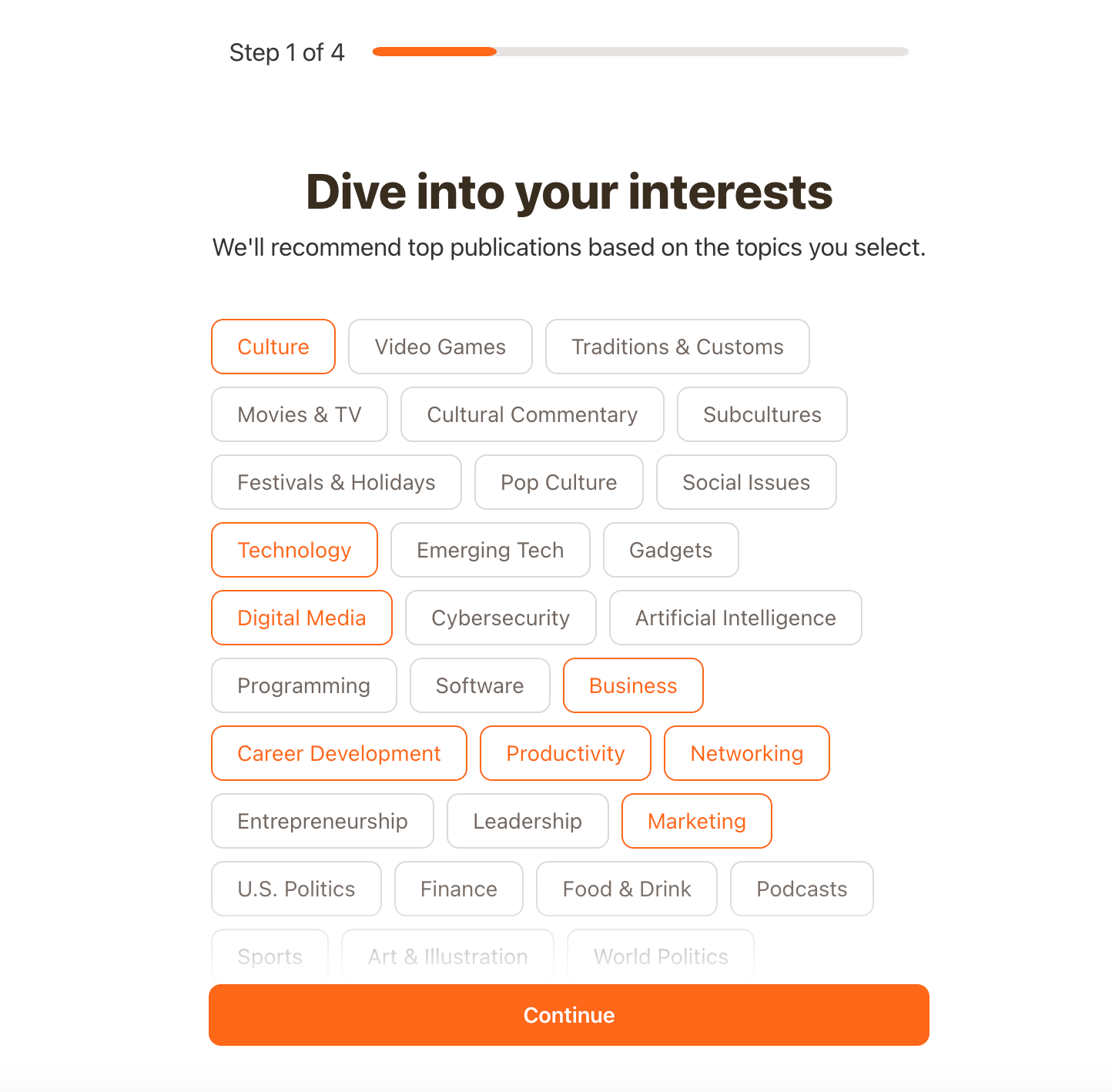
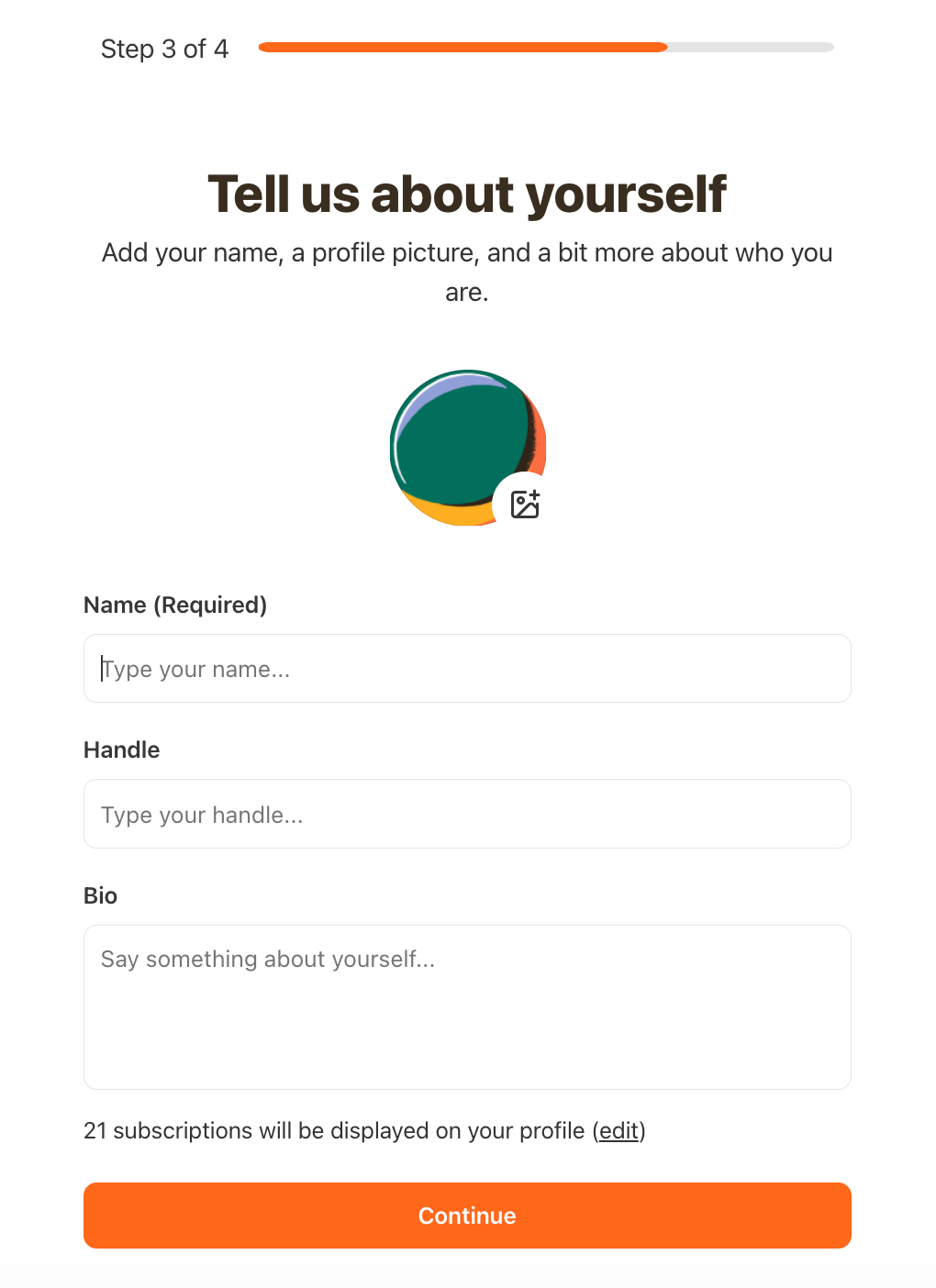
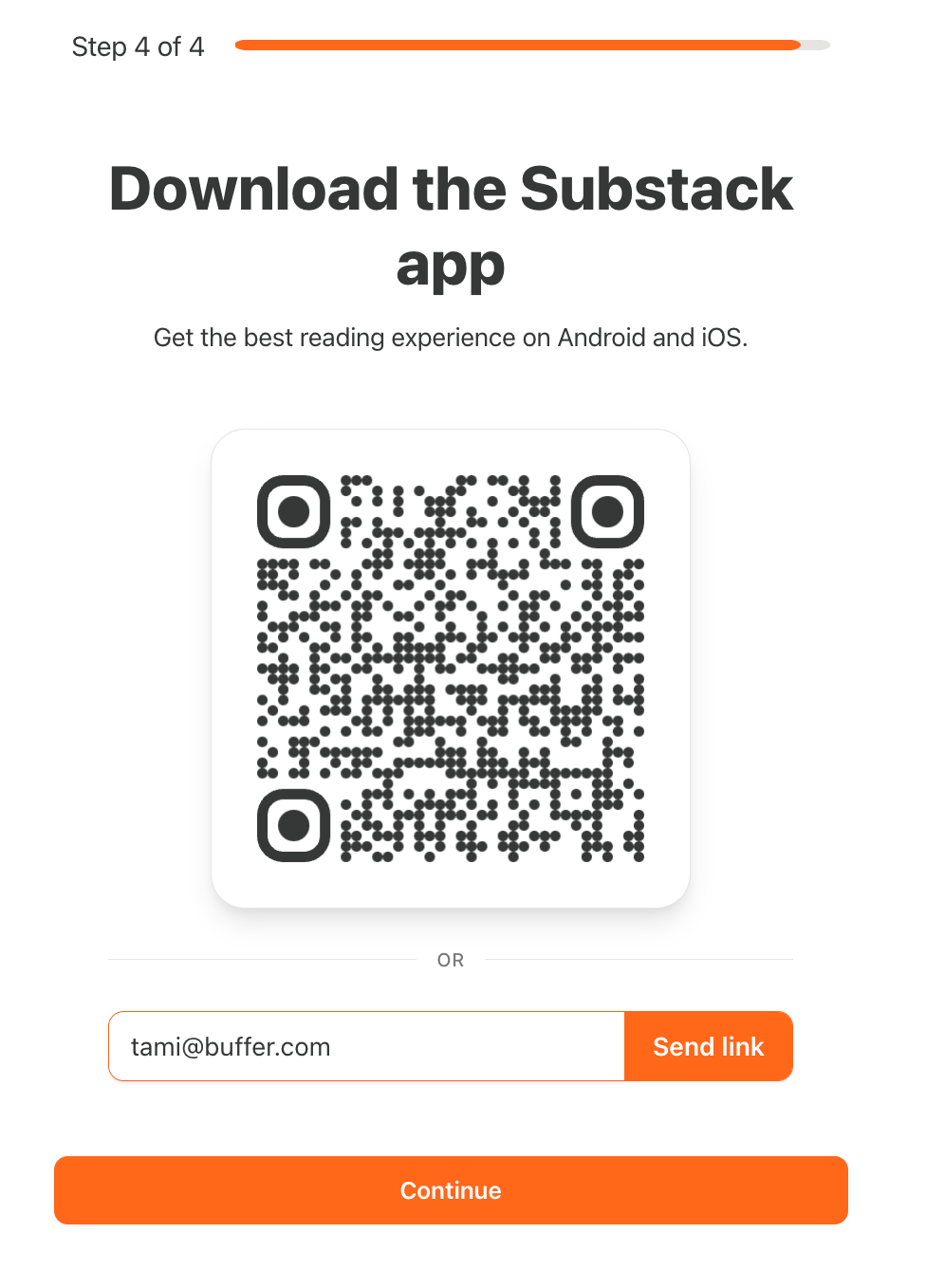
Your profile is your Substack "about me" section—it appears on your newsletter page and in every email footer.
On your profile page (which you can access through the images at the top-right or bottom-left of your homepage), click Settings to edit your profile picture, name and bio.
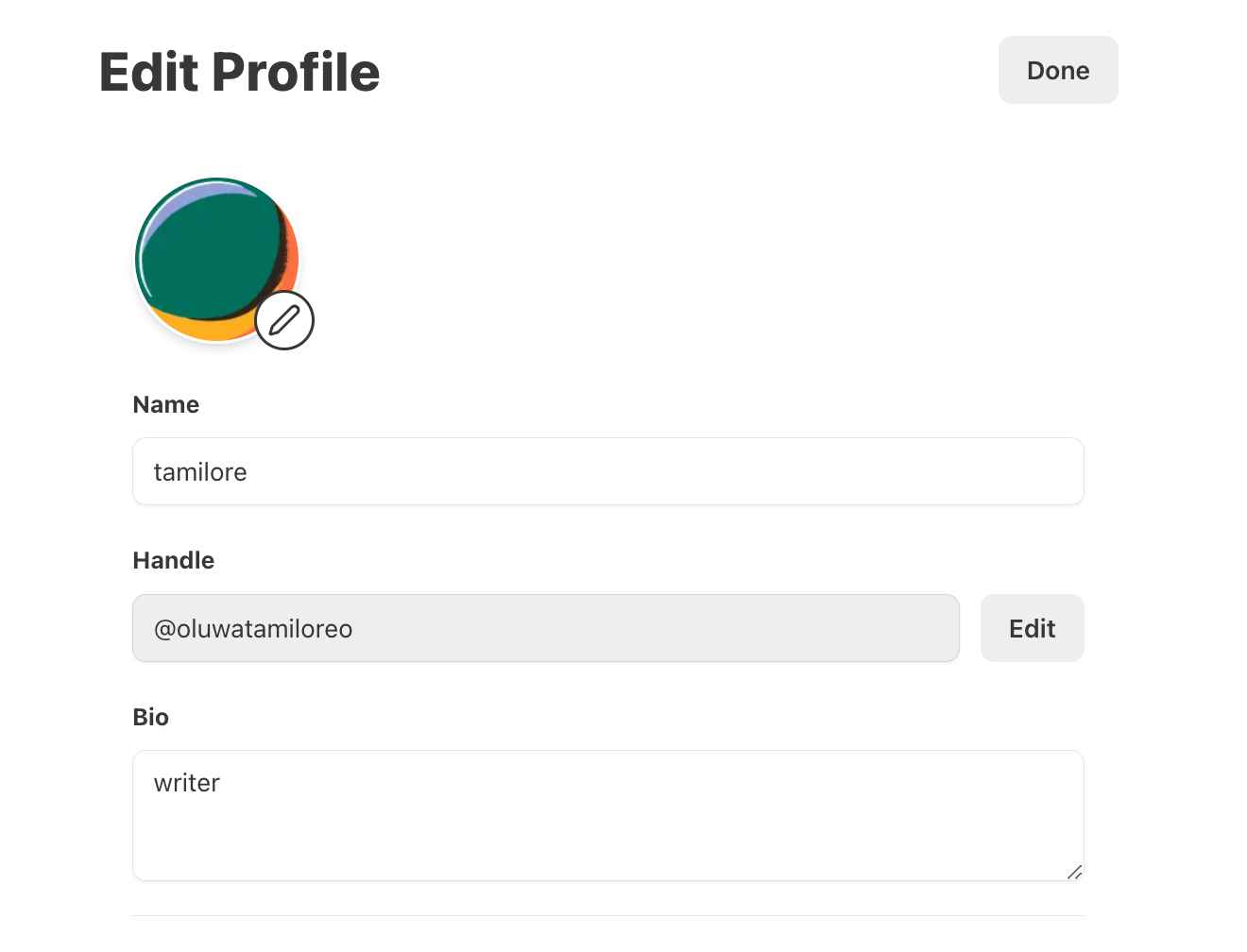
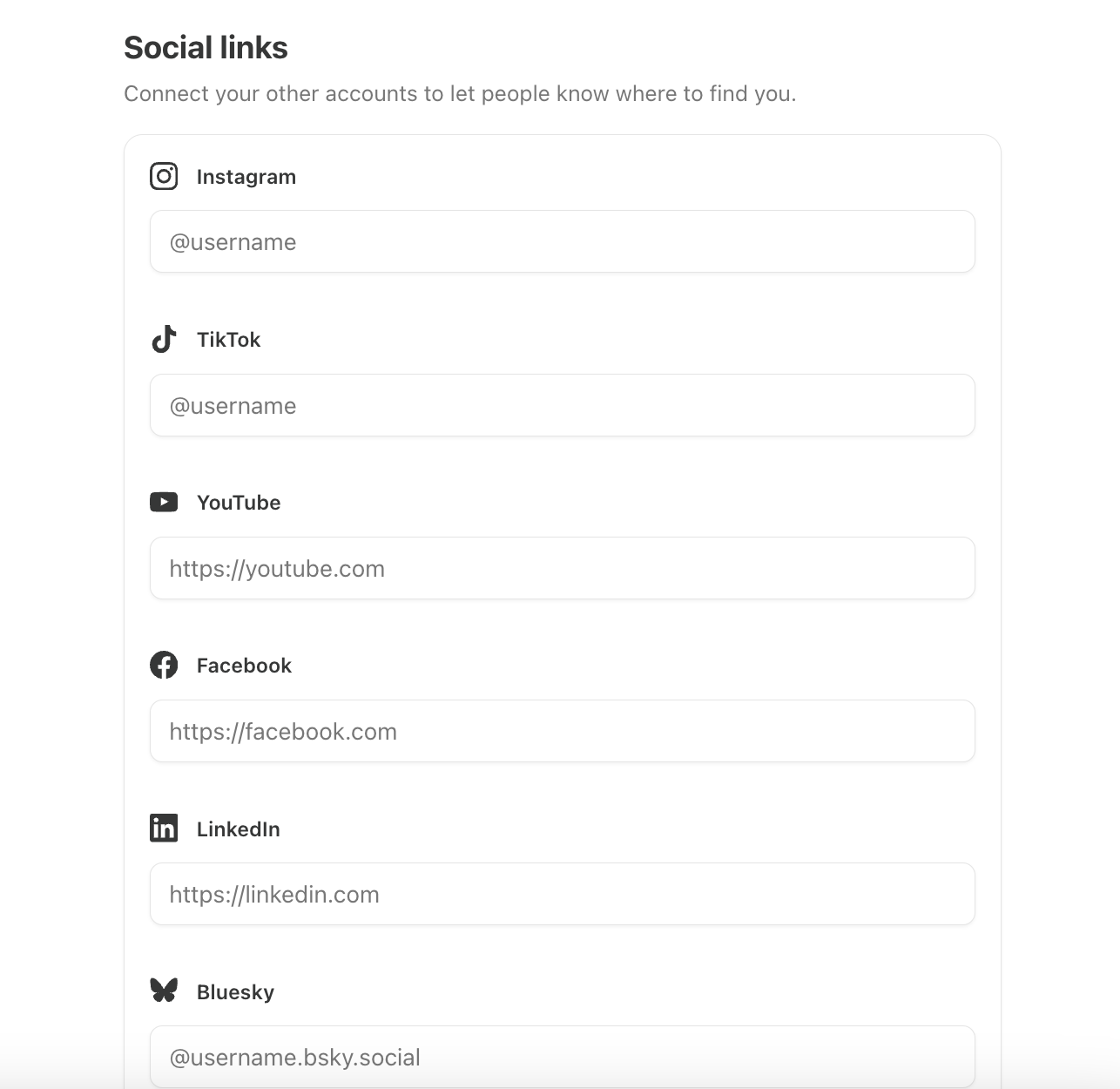
Your image can be a picture of you or a logo for your newsletter. However, a well-written bio helps potential readers quickly understand what you and your newsletter are about and why they should care.
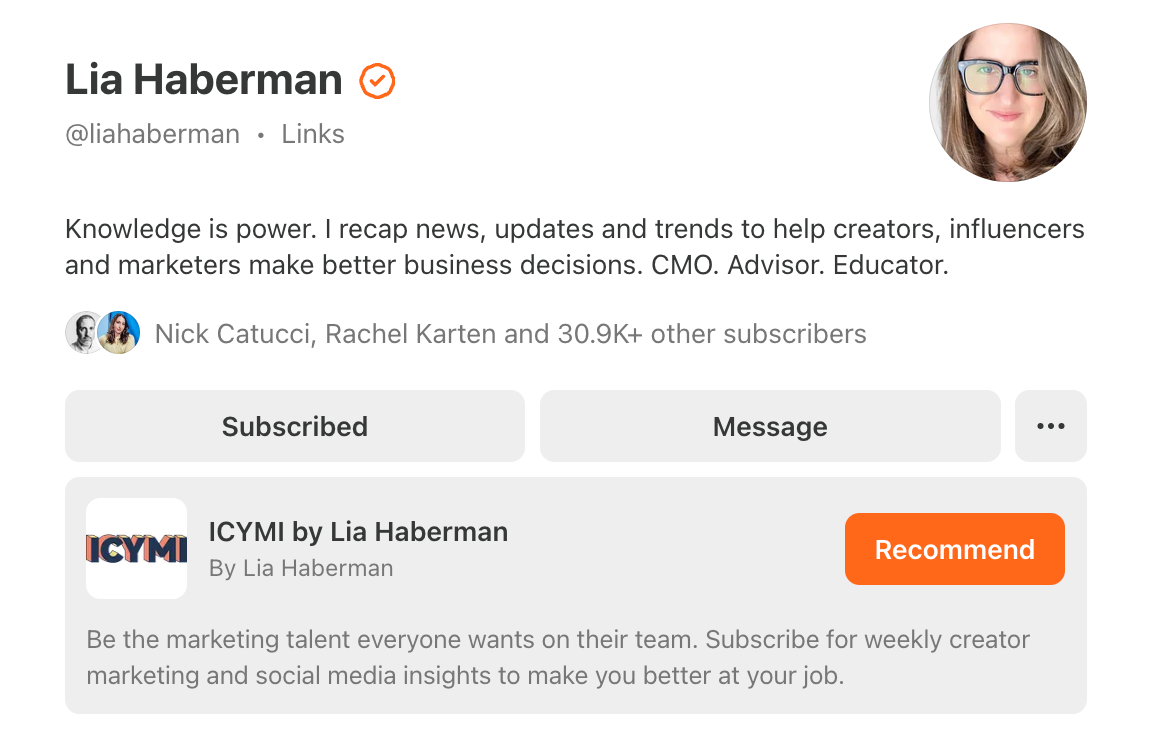
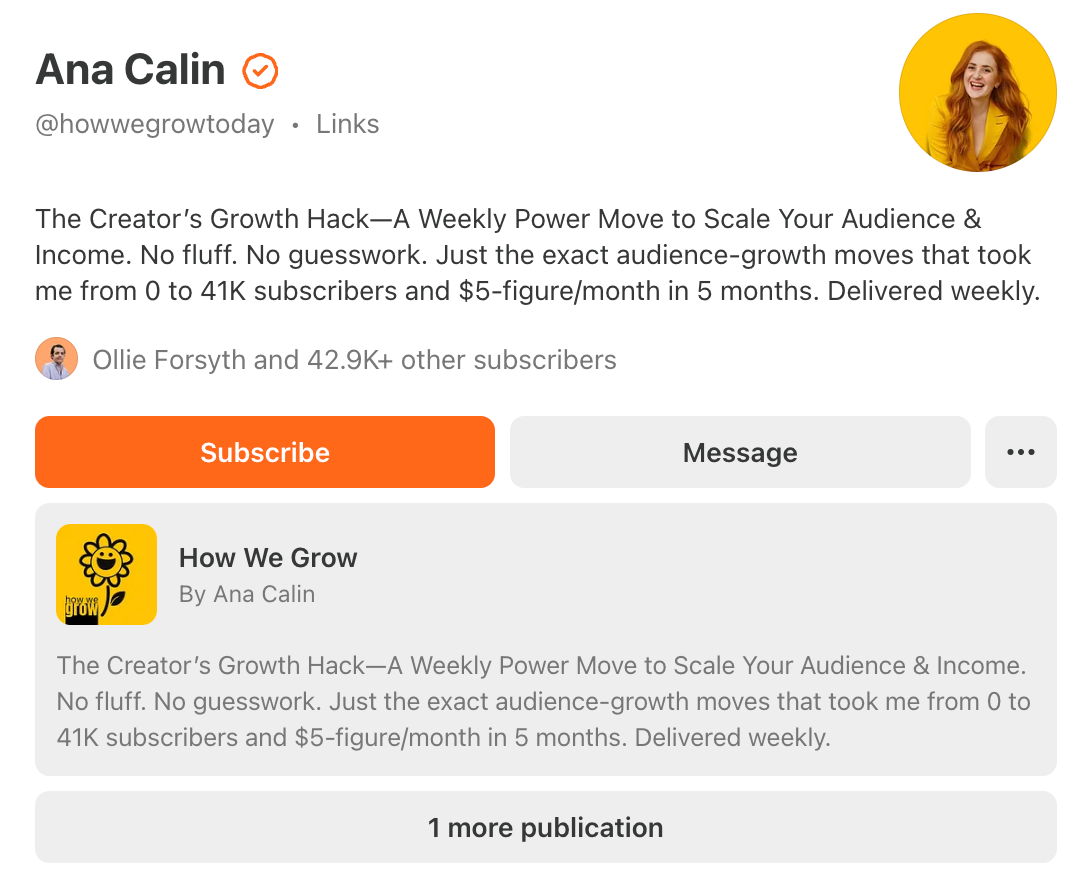
A strong bio:
- Clearly states the newsletter’s focus
- Highlights who it’s for
- Uses a conversational, approachable tone
For example, instead of:
"I’m a marketing expert sharing my thoughts on digital trends."
Try:
"Every week, I break down digital marketing trends into actionable strategies—so you can grow your brand without the guesswork."
You can (and should) also connect your social media so that people can find you elsewhere.
2. Set up your newsletter as a publicationOnce your account is set up, select Start Writing on your home page to start setting up your newsletter.
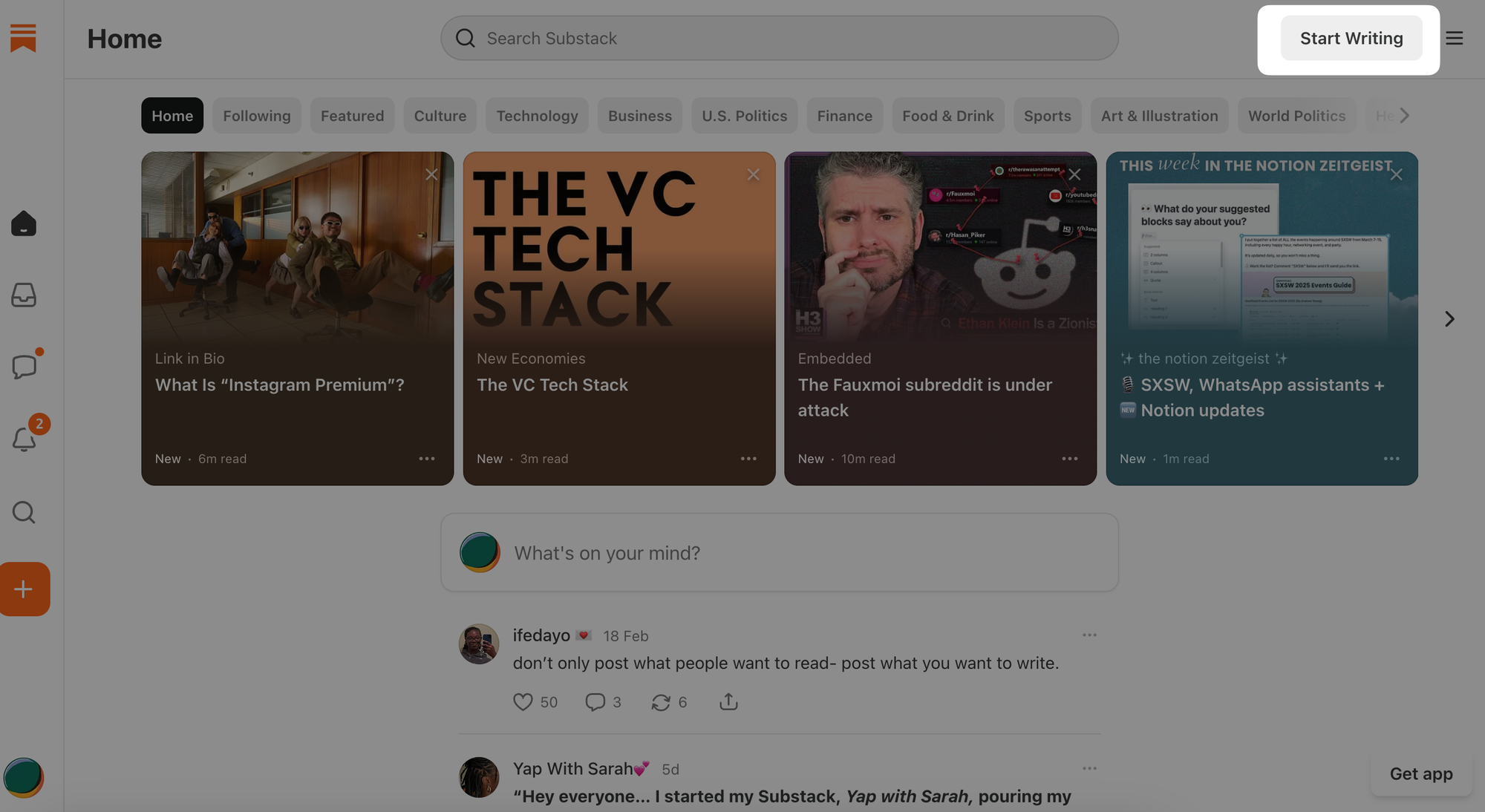
You’ll be taken to a new blank page, but I recommend you hit the back button to customize your newsletter before you start publishing.
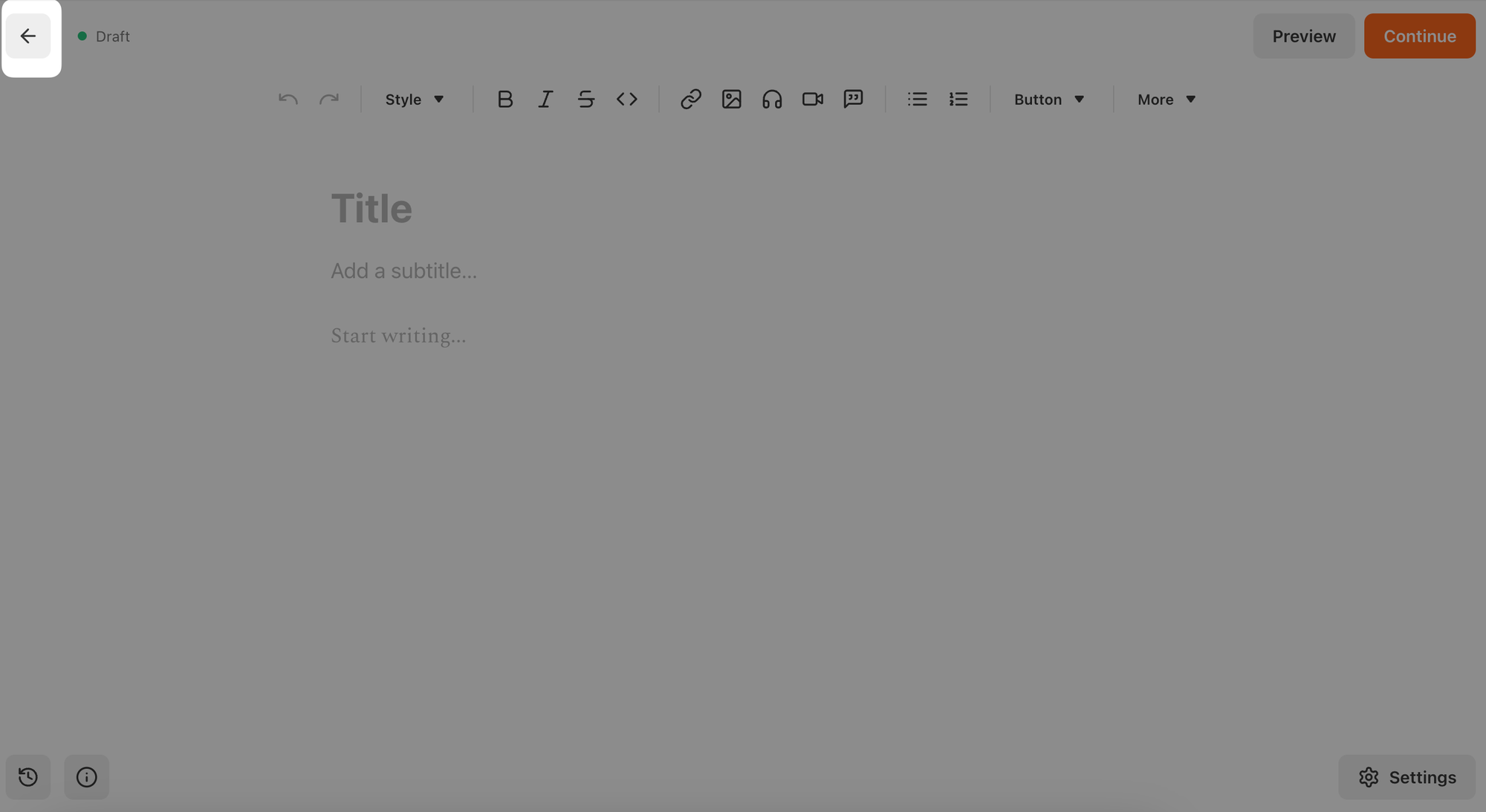
Once you're on the homepage, click on the Settings button to set up your newsletter properly.
First, you'll need to scroll to the bottom of the Settings page, then select Convert to publication to gain full customization capabilities.
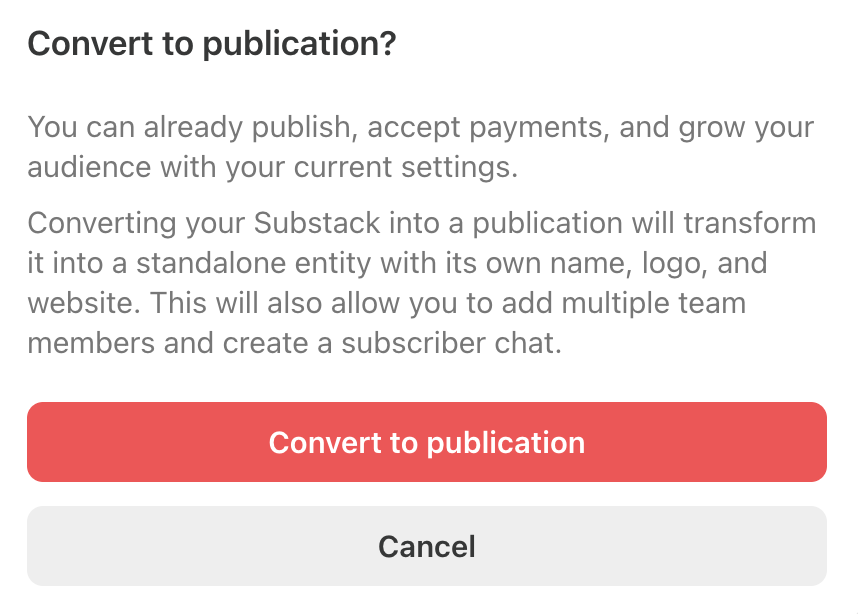 💡Note: This is optional – you can still publish posts to Substack without this process. However, this allows more customization that will impact the rest of this how-to.
💡Note: This is optional – you can still publish posts to Substack without this process. However, this allows more customization that will impact the rest of this how-to.Now, you can change your newsletter name, add branding, welcome emails and other custom content. Here are a few key options to check:
- Publication design: Upload a logo or banner and choose a simple color scheme. Substack doesn’t allow heavy customization, but small branding touches can make your page feel more polished.
- Welcome message: Customize the automated email that new subscribers receive. This is your first direct interaction with readers—use it to introduce yourself and set expectations for what they’ll receive.
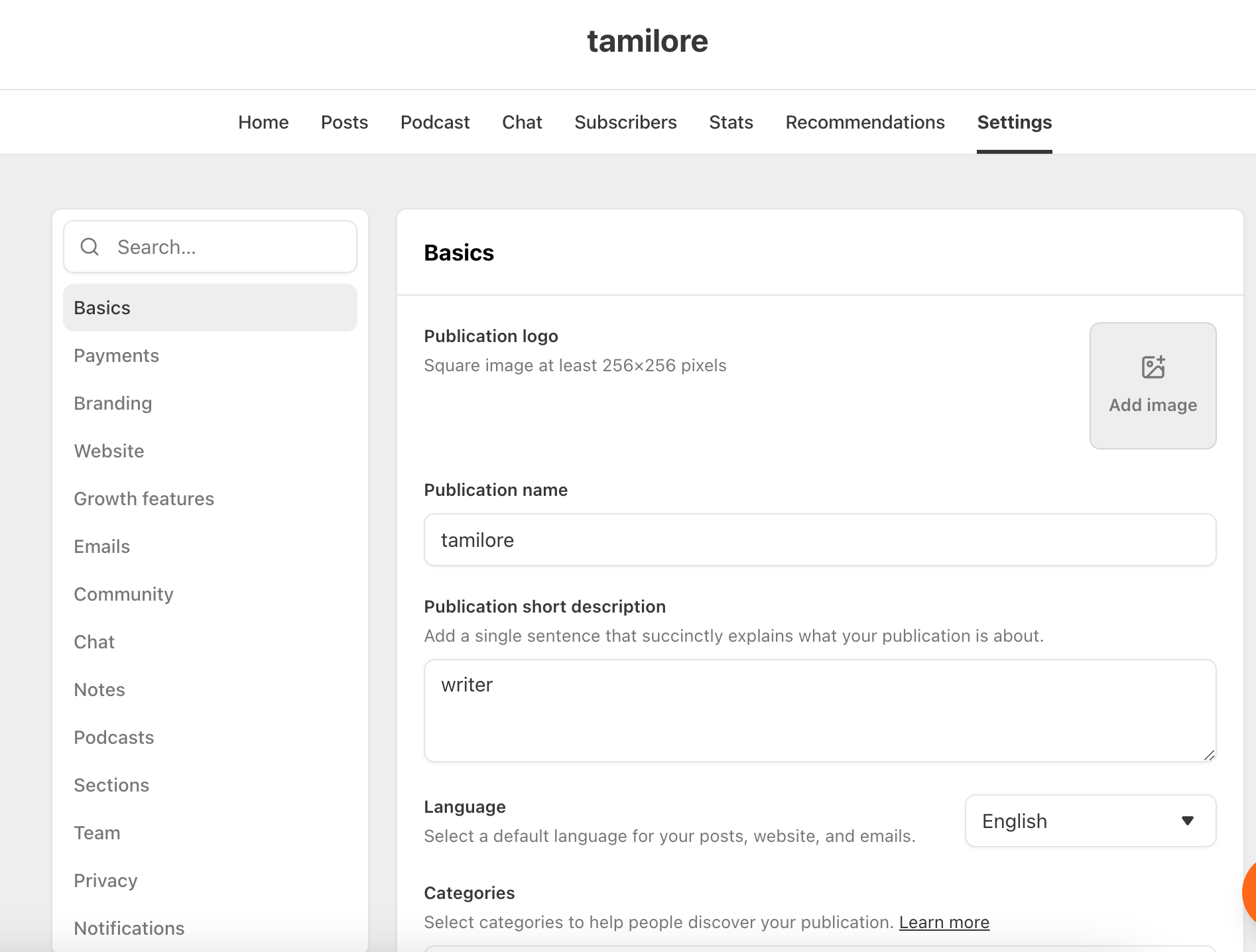
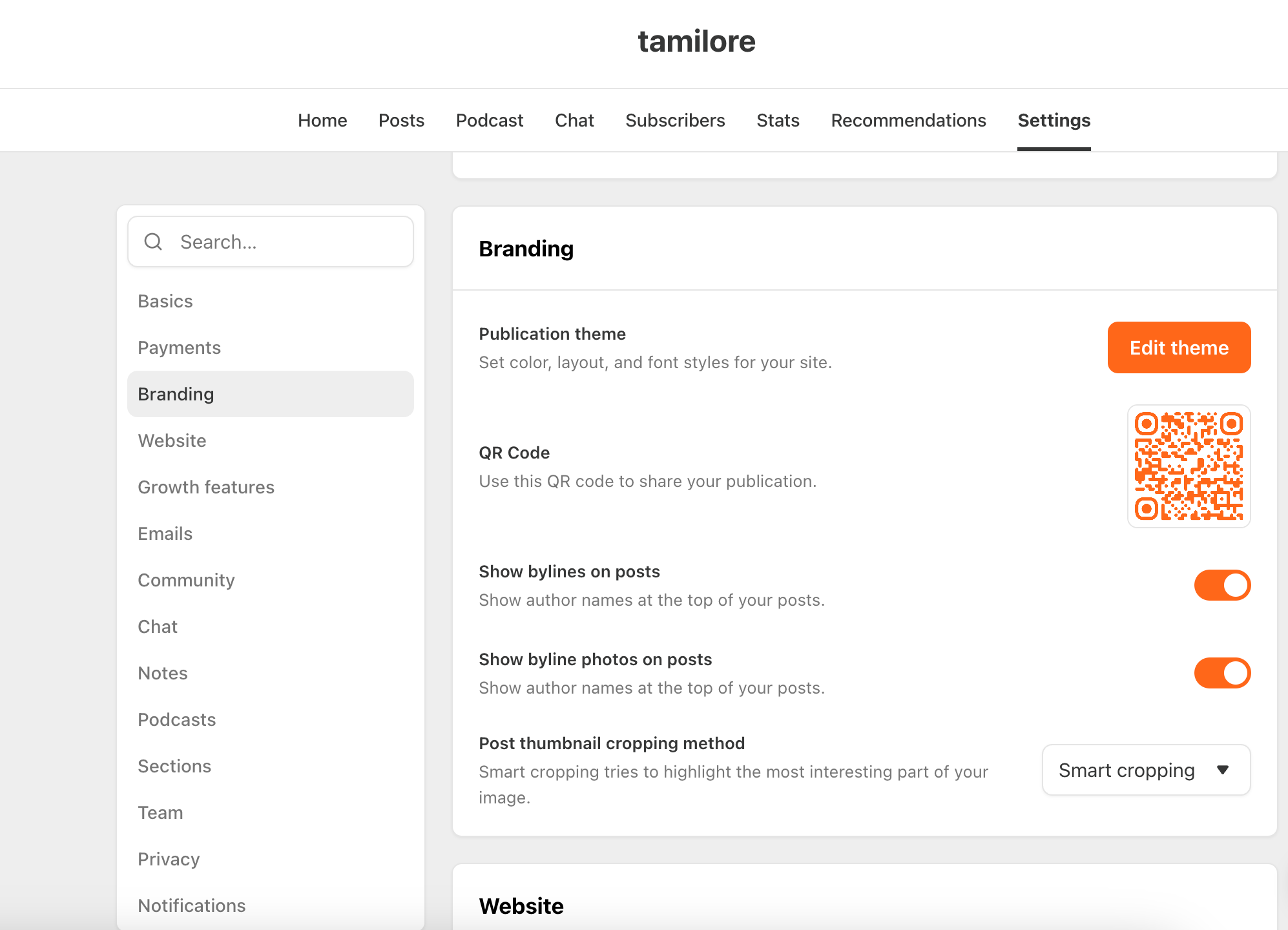
And if you need to take a pause before you set up, Substack will have this handy checklist waiting for you in your Dashboard.
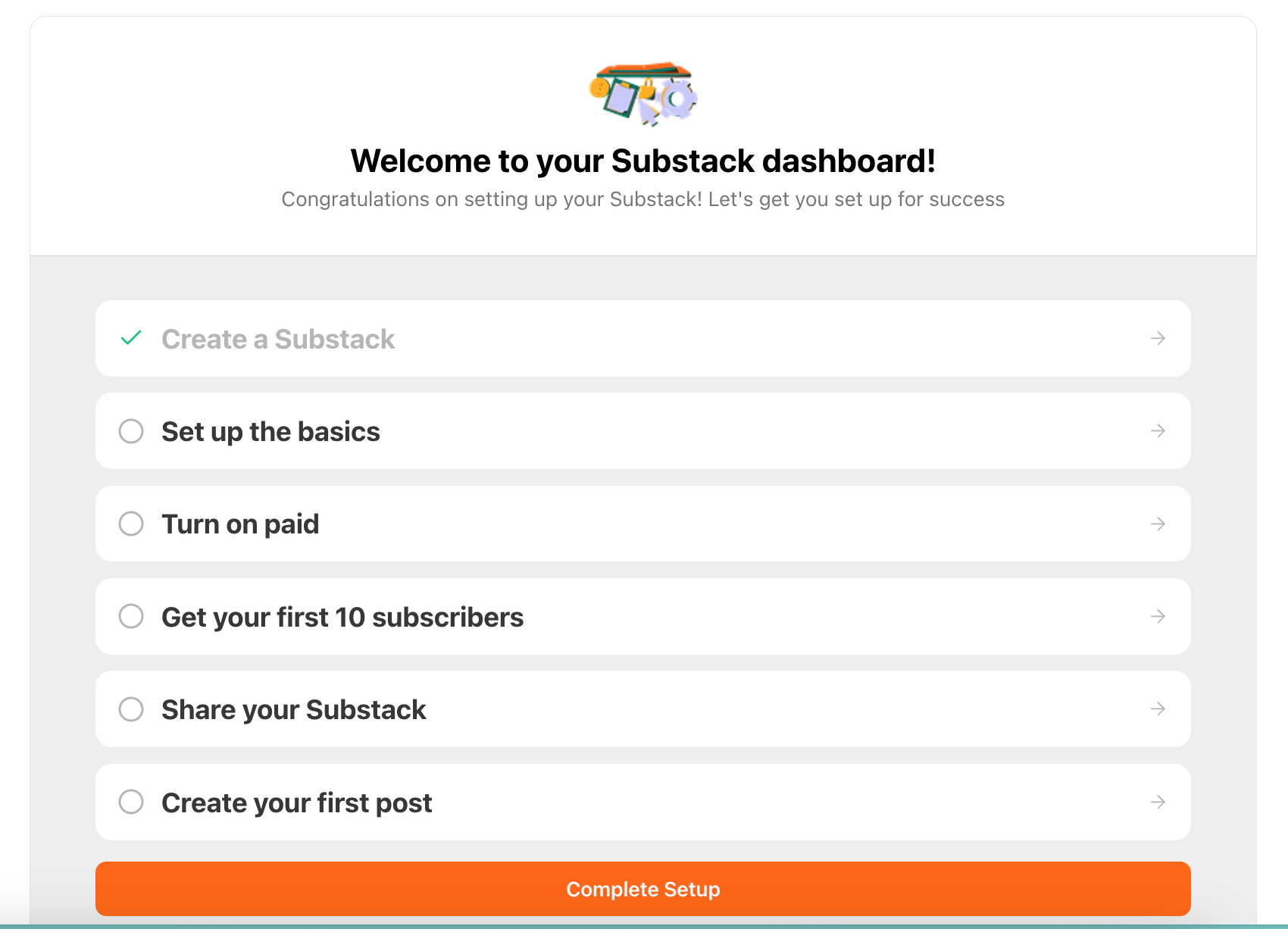 3. Write a welcome post (optional but recommended)
3. Write a welcome post (optional but recommended)A welcome post isn’t required, but it’s a great way to introduce yourself and your content before you start sending regular newsletters. It also gives first-time visitors something to read when they land on your page. Some creators go super detailed, while others keep it simple.
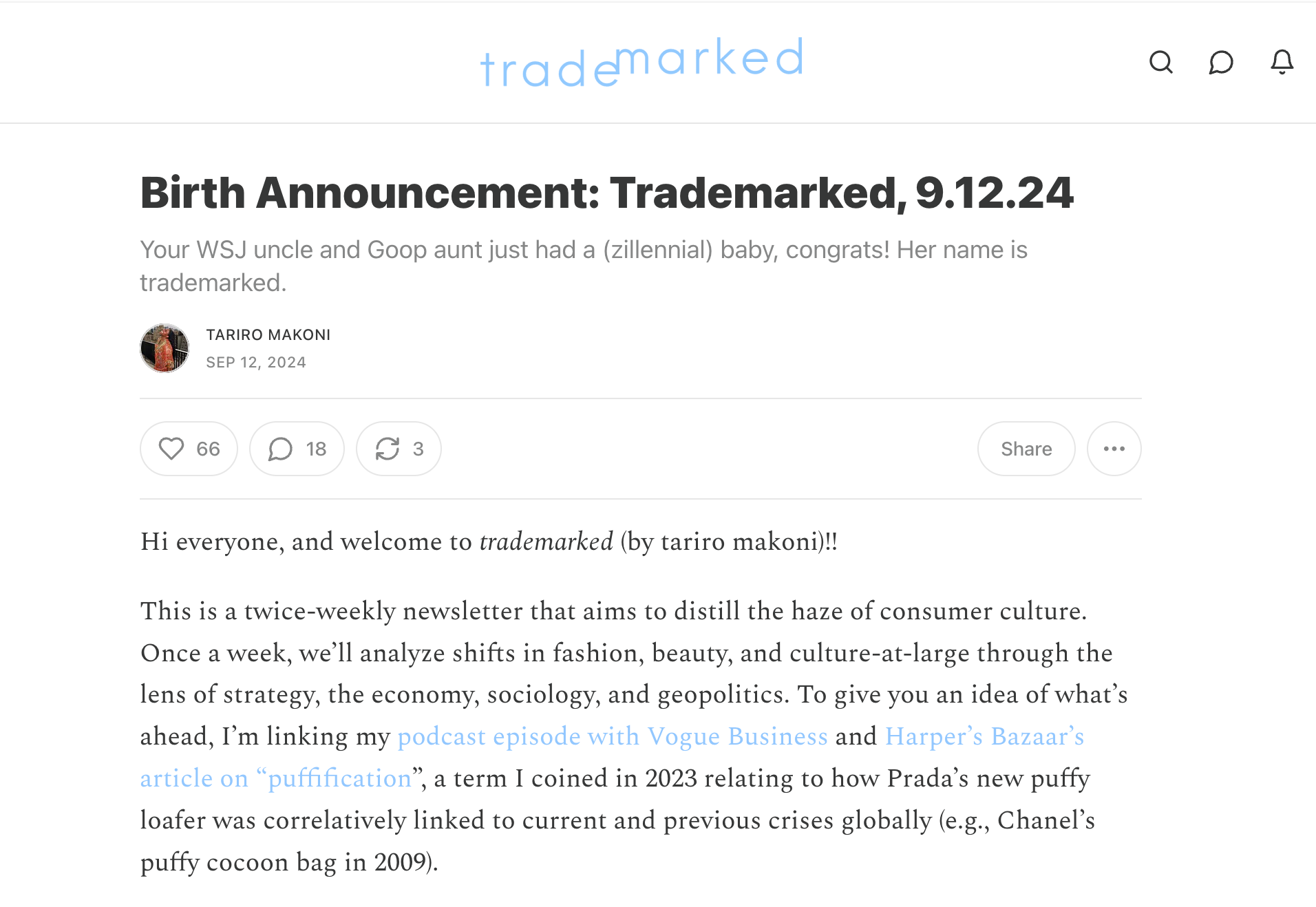
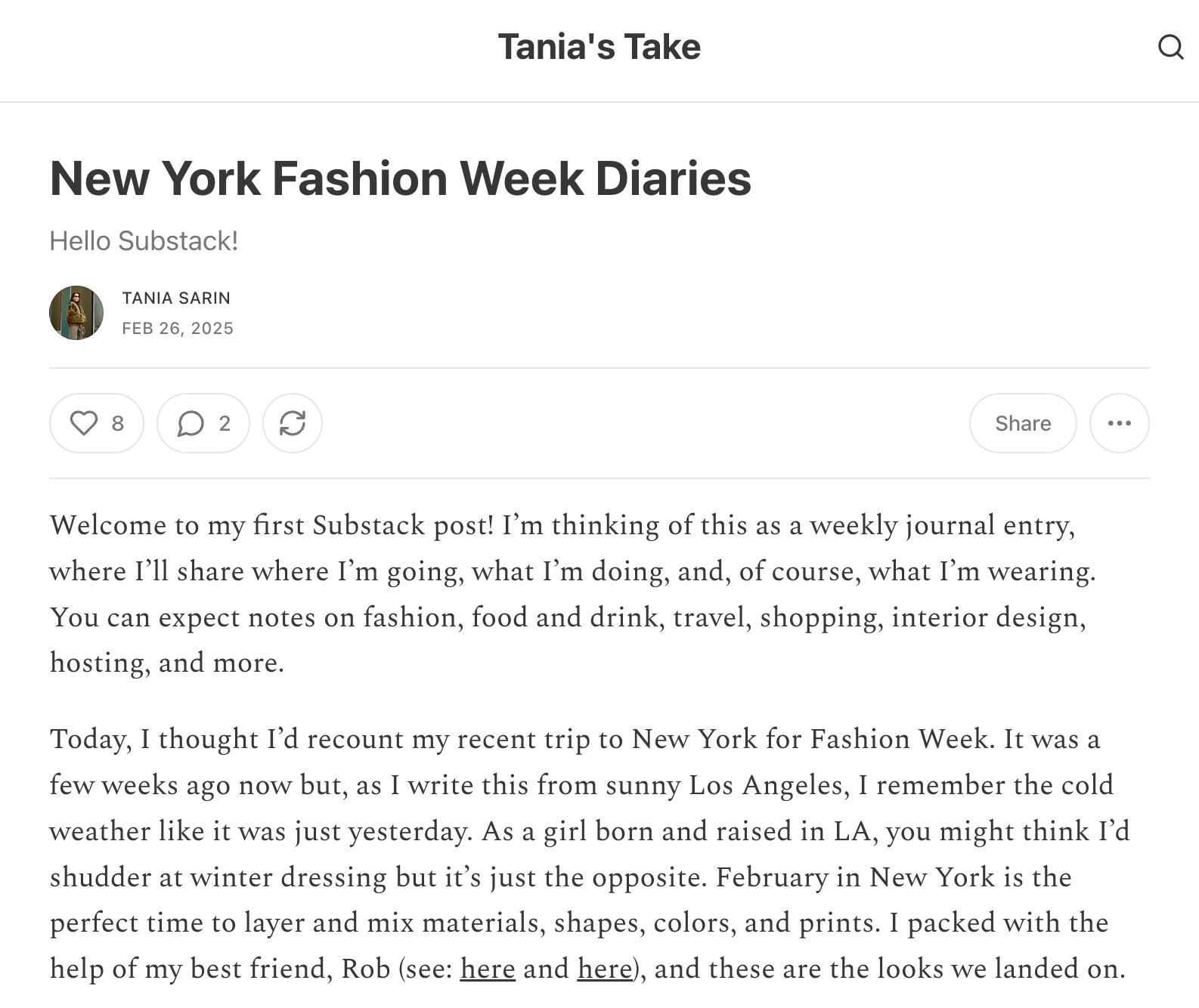
A simple format for a welcome post:
- Introduce yourself: Who you are and why you’re starting this newsletter
- Explain what readers can expect: The topics you’ll cover and how often you’ll publish
- Encourage engagement: Ask readers to reply with their thoughts or share the newsletter with others
If you have an existing audience—on social media, LinkedIn, or elsewhere—now’s the time to inform them about your newsletter.
Substack makes this easy with tools like:
- A unique subscribe link to share anywhere
- An import feature to bring in email lists (as long as you have permission)
- Embeds and buttons to add a signup form to your website
Don’t wait until you have the perfect newsletter to promote it. Start sharing your Substack as soon as possible—you can refine it as you go.
How to develop a winning content strategy for SubstackOnce your Substack is set up, the next big question is: What should I write about?
While there’s no single “right” way to approach Substack, the most successful newsletters tend to have a clear focus, a consistent publishing rhythm, and a strong voice.
I asked the creators how they plan their content, and their advice boils down to three key steps.
1. Define your niche (or at least your starting point)Before publishing your first post, it helps to have a general idea of what you want to write about. Your niche doesn’t have to be hyper-specific, but a clear focus makes it easier to attract the right audience.
It can give you a serious advantage in search, as Lade Falobi, who shares product marketing insights in Marketing for Geeks, shares, "I wish I’d known to optimize for search earlier. It’s not just about writing great content—you have to make it easy for people to find you."
Some questions to help define your niche:
- What topics do you enjoy writing about?
- Who do you want to attract as readers?
- What unique perspective or expertise do you bring?
That said, don’t overthink it. Some of the best newsletters started with writers simply exploring ideas and refining their niche along the way.
2. Choose a format that works for youOnce you have a general topic, think about how you’ll structure your newsletter. Will it be essay-style deep dives? Short insights? Curated industry news? Interviews?
You don’t have to limit yourself to “traditional” formats — some of my favorite creators go against the grain to share incredibly formatted content, like Gabby Whiten, who writes Oh Eight, a lifestyle and fashion newsletter, and creates these elaborate collages for each issue.
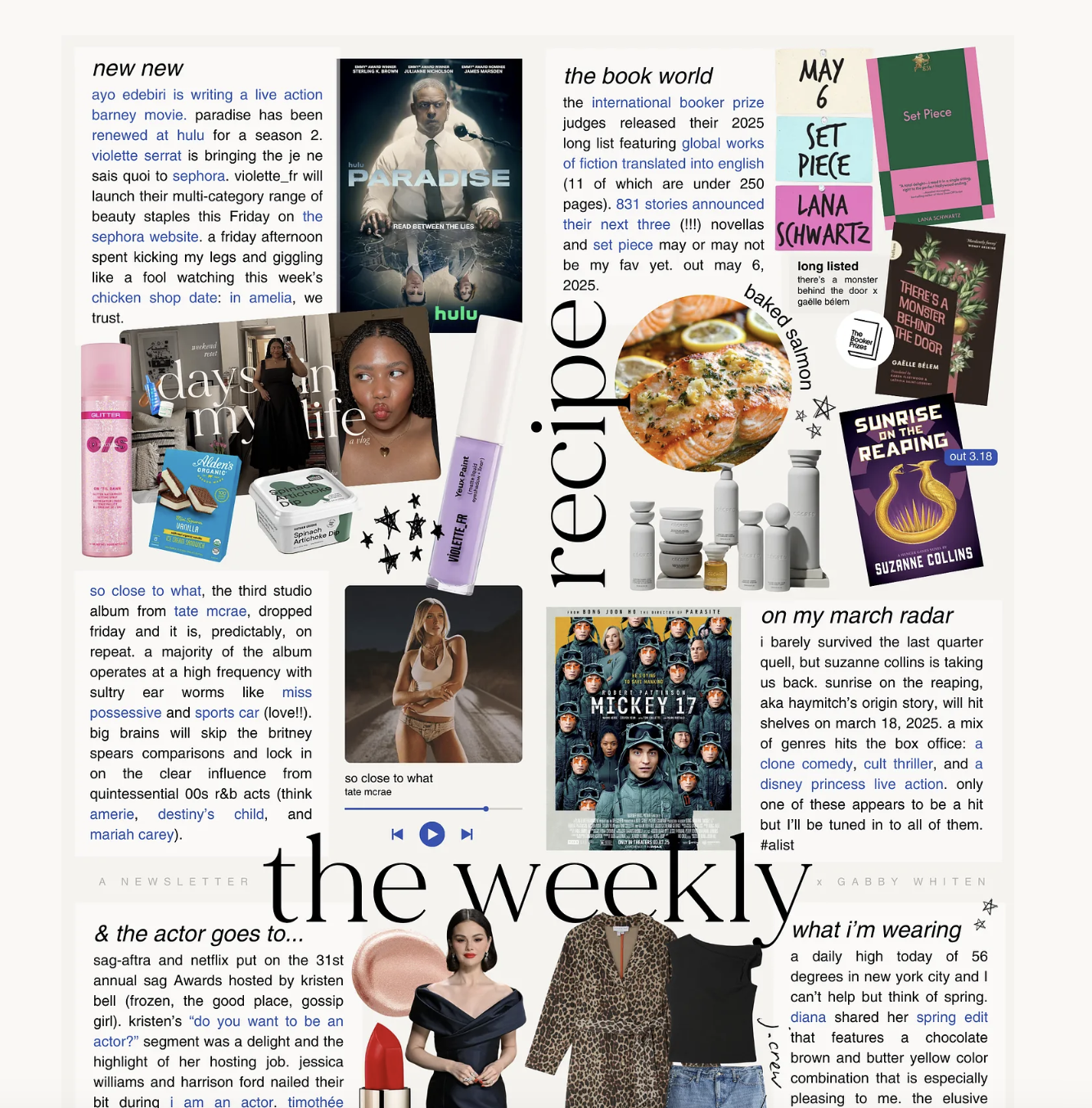
Some popular newsletter formats on Substack include personal essays or storytelling, practical guides & how-tos, curated content, and interviews & case studies.
There’s no right or wrong choice, so just pick a format you’ll enjoy writing consistently.
3. Set a realistic publishing scheduleConsistency is key on Substack, but that doesn’t mean you must publish constantly. The best schedule is one you can stick to without burning out.
A common rhythm for new writers is once a week, but some creators publish biweekly, while others send updates multiple times a week.
4. Quality over quantityThe biggest mistake new writers make? Publishing for the sake of publishing. Consistency matters, but high-quality, valuable content is what keeps readers subscribed.
Rather than stressing over frequency, focus on delivering posts that inform, entertain, or challenge your readers in some way.
How to grow your audience on SubstackOnce you’ve started writing, the next challenge is getting people to actually read your newsletter. Unlike social media platforms, where content can go viral overnight, newsletter growth tends to be more gradual—but that doesn’t mean it has to be slow.
I asked Substack creators what worked for them, and their responses revealed a few key strategies for building an engaged audience.
1. Use Substack’s built-in toolsOne of Substack’s biggest advantages over self-hosted email lists is its built-in discovery features. Readers can find you through Substack Recommendations, the Substack app, and Notes (Substack’s short-form social feed). To maximize Substack’s discovery features:
- Turn on Recommendations: This lets you recommend other newsletters, and in return, others may recommend yours. Many writers say this is one of the most effective growth strategies.
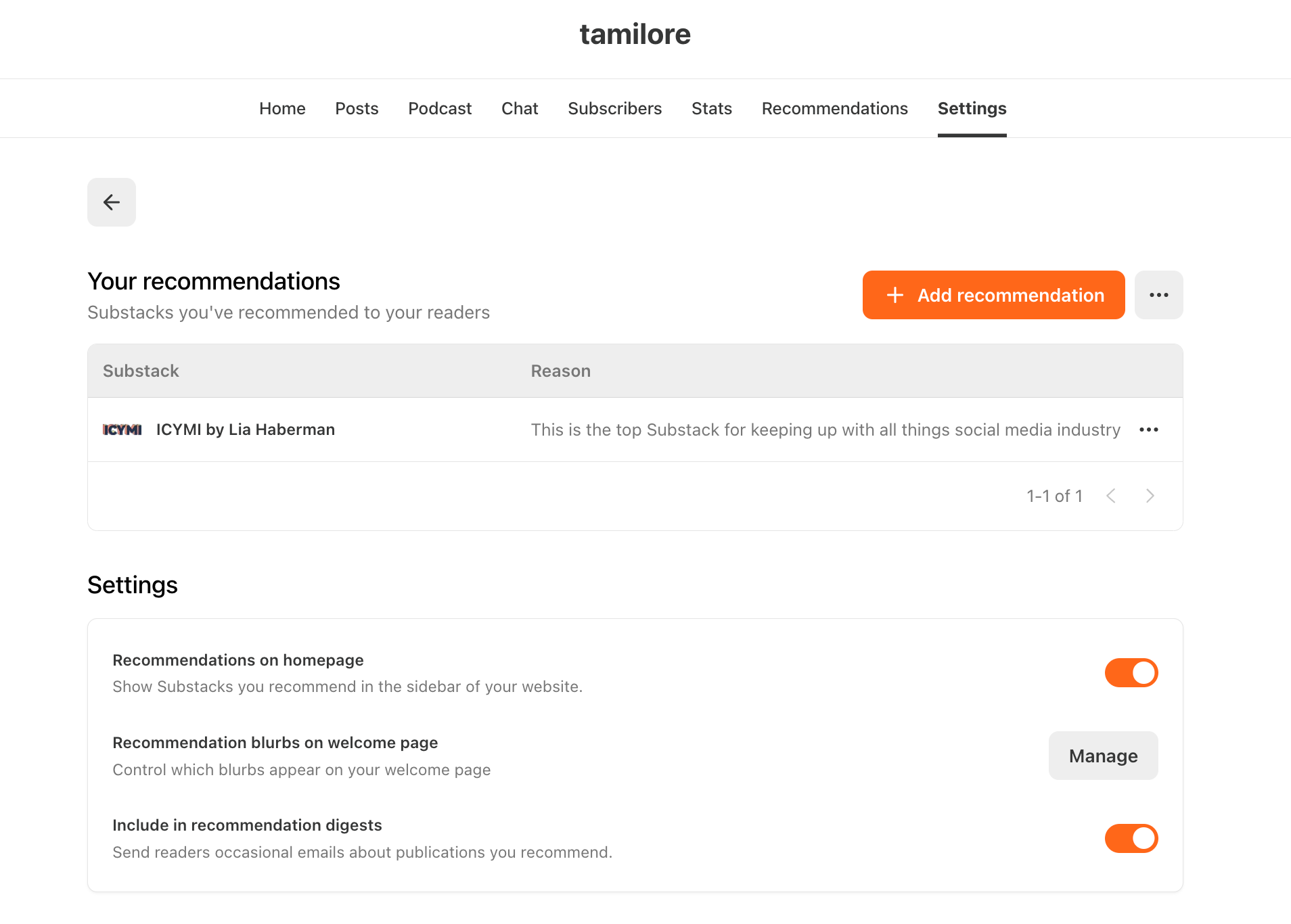
- Use Substack Notes: This works like a Twitter feed but within Substack’s ecosystem. Sharing thoughts, links, or even snippets of your posts can help attract new subscribers. Success Lawal, who writes Dear Digital Marketing Newbie, says, "Substack Notes has been useful for sharing short updates and engaging with my audience outside of just newsletters."
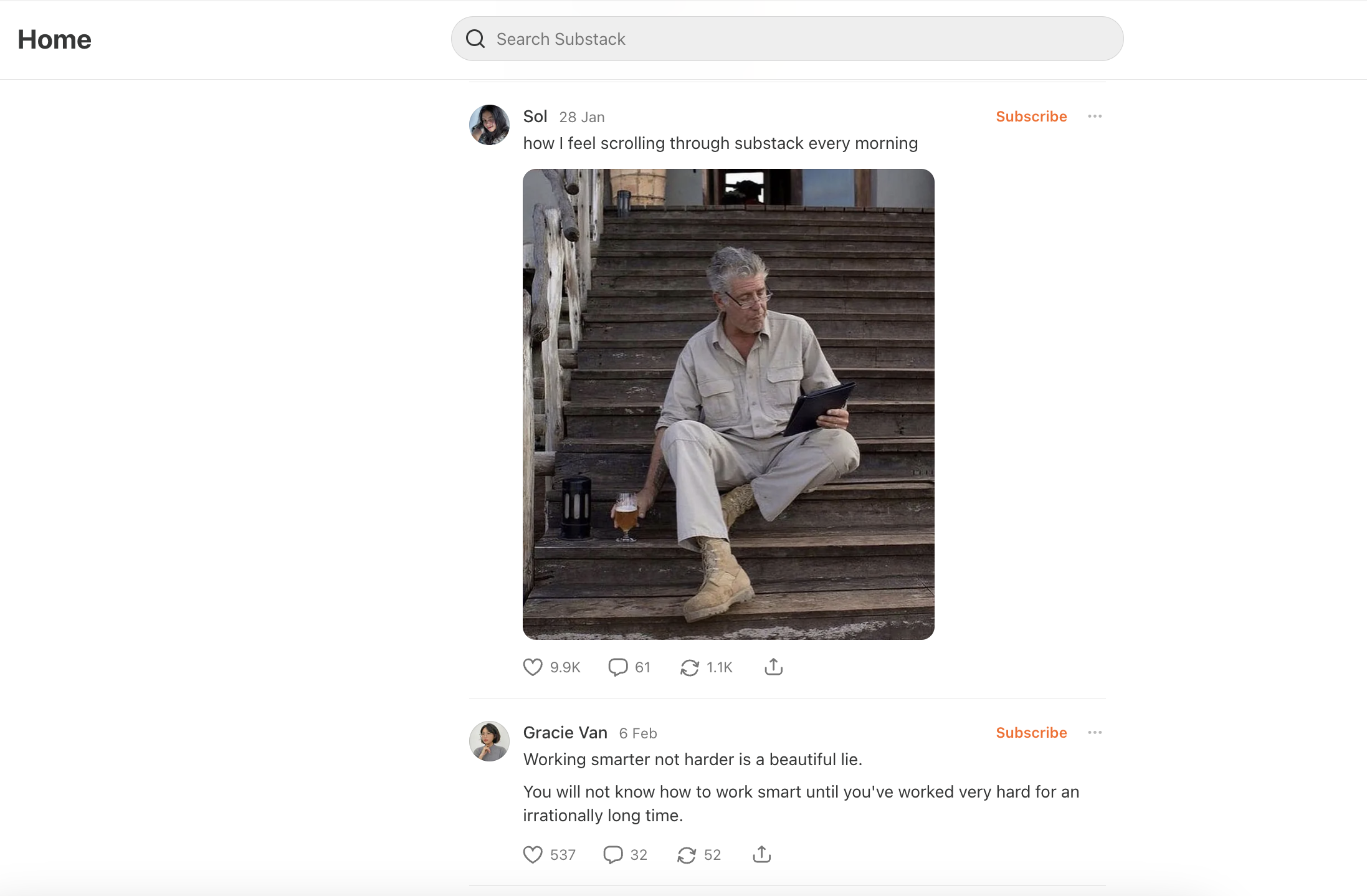
- Engage in Substack Chat: If you have paid subscribers, Chat allows for direct, paywalled community engagement, which can increase retention and word-of-mouth referrals.
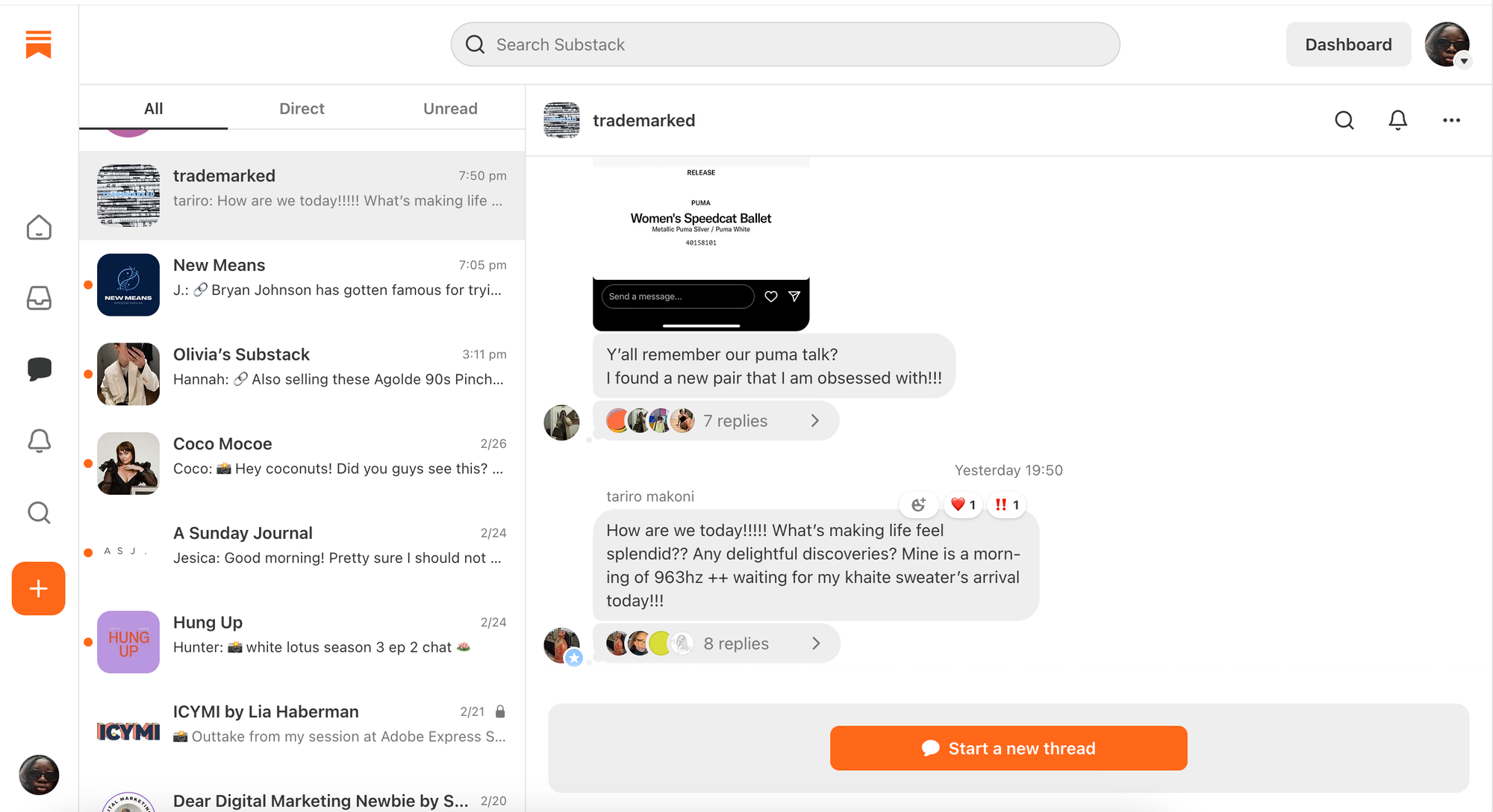
Finally, like many other social platforms, keep an eye out for new features and take advantage of them. For example, Substack just introduced a video feed and while it’s not super popular yet, it’ll be a great way to start promoting your content within the app.
2. Promote on social media strategicallyMany creators grow their Substacks by consistently sharing their content on social platforms like X, LinkedIn, TikTok, and Instagram. The key? Posting teasers, insights, and value-driven content instead of just dropping a link.
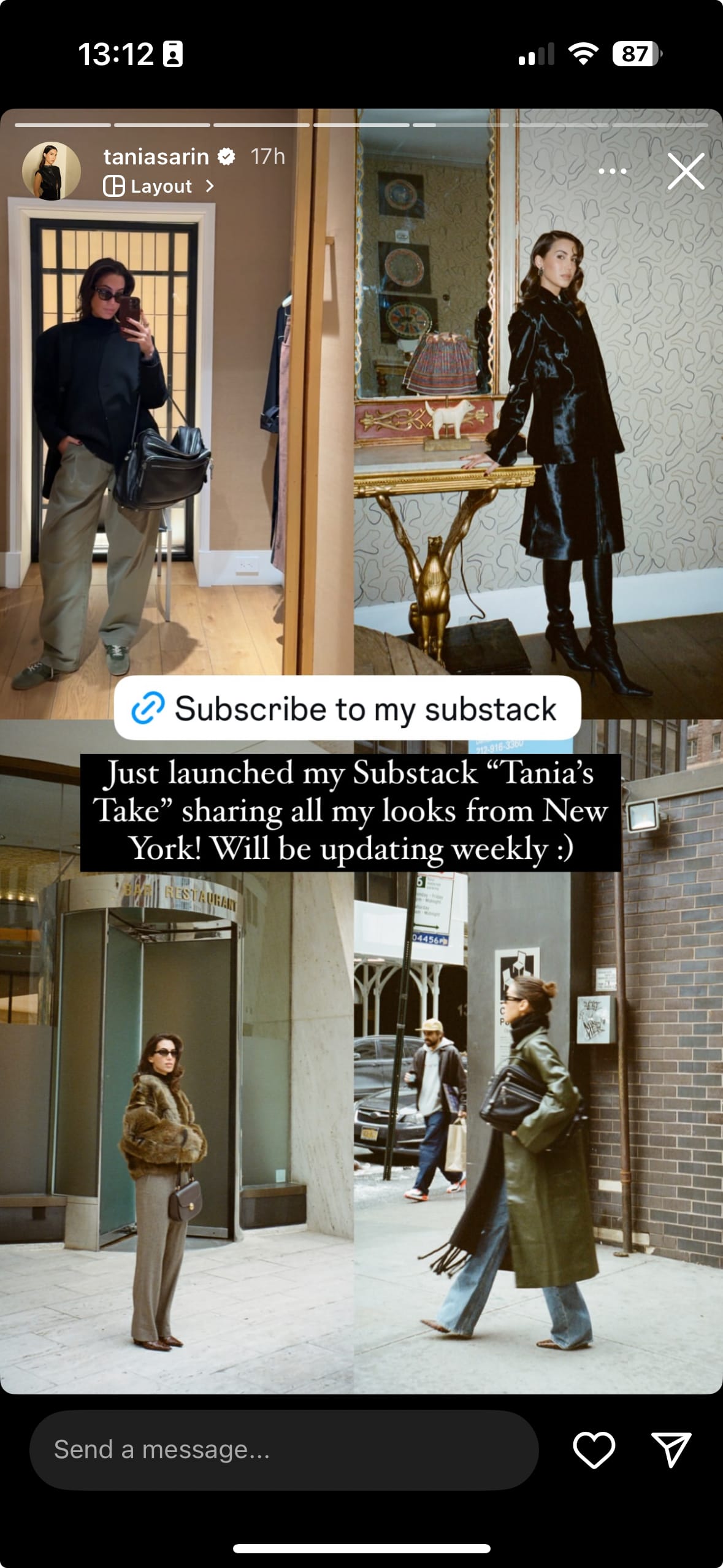
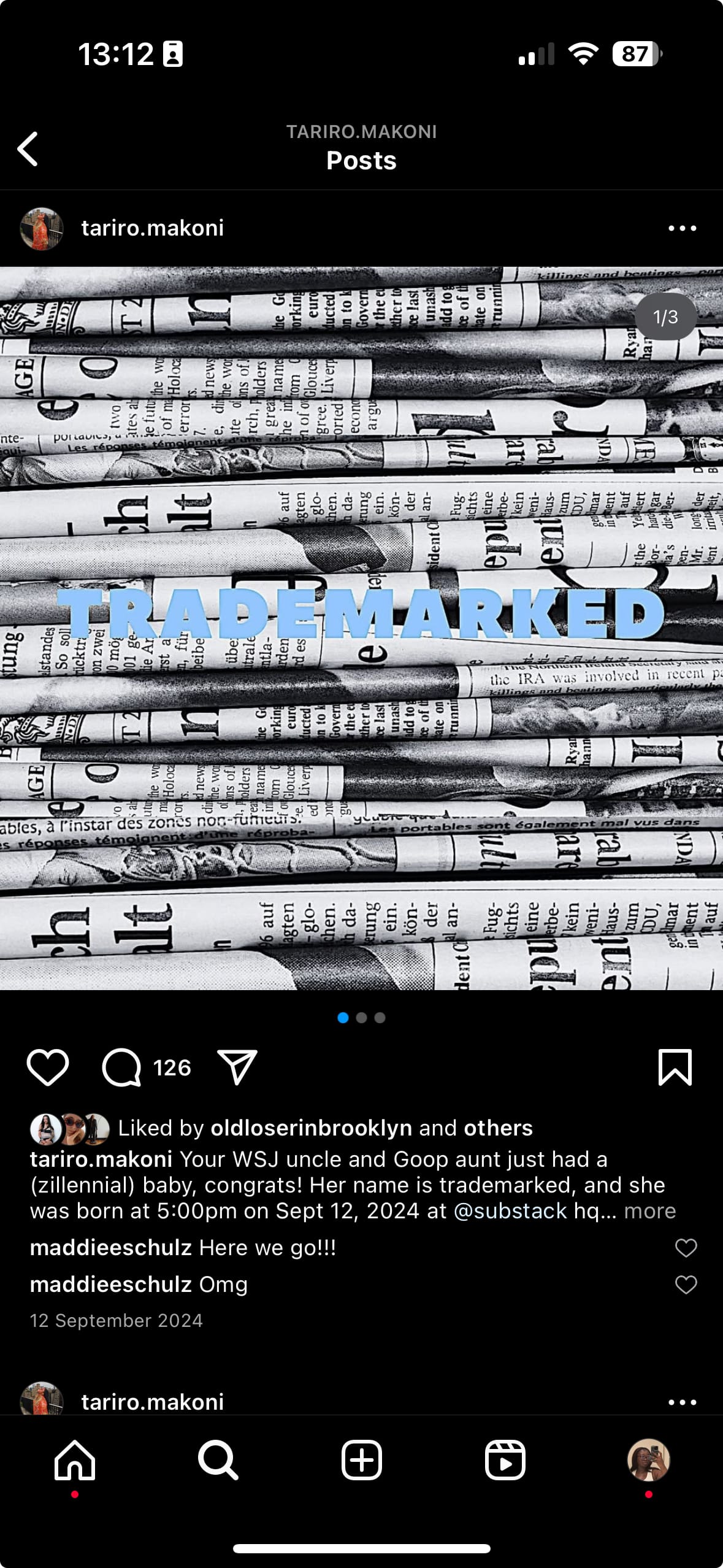
Using Substack’s internal features is also one way to leverage social media, as Anna Burgess Yang shared, "Very, very recently, I started 'restacking' quotes from other Substack writers as a way to boost visibility. It’s been interesting to see how that helps in engagement."
If your content is visual or educational, consider repurposing newsletter content into carousels or short videos and share short, engaging takeaways then link to your full post.
3. Cross-promote with other newslettersOne of the fastest ways to grow on Substack is by collaborating with other writers in your niche. Cross-promotions, guest features, and newsletter swaps can expose your content to an entirely new audience.
You can do this by reaching out to other writers to feature their work or offer to write a guest issue for another Substack.
4. Convert readers into advocatesSome of the best subscribers come from word-of-mouth. The best way to encourage this? Ask your readers to share. A simple “If you enjoyed this, consider forwarding it to a friend” at the end of your emails can work wonders.
You should also consider recognizing active readers to create a stronger community and encourage sharing.
While Substack doesn’t have a built-in referral program (yet), some writers manually track referrals and offer small perks like exclusive content.
How to monetize on SubstackSubstack’s biggest selling point for many writers is its built-in monetization tools. Substack allows creators to get paid directly by their audience through paid subscriptions.
But when is the right time to introduce a paid tier? How do you actually get people to pay? And are subscriptions the only way to earn?
- When should you start charging? One of the biggest decisions new Substack writers face is when (or if) to introduce paid subscriptions. Some start charging from day one, while others build a free audience first. "I turned on monetization from the beginning, and it will be interesting to see how it goes. I didn’t want to wait until I had a certain number of subscribers." says Amer Hamidi-Sakr, who writes The Legacy Blueprint, a newsletter on philosophical topics. If you’re hesitant to do this, don’t worry. A common approach is to wait until you have at least a few hundred engaged free subscribers before launching a paid tier. This gives you time to build trust, establish a writing rhythm, and understand what your audience values most. If you’re unsure, consider a soft launch—turn on the paid option, but don’t heavily promote it yet. That way, early supporters who want to pay can do so while you continue growing your free audience.
- How much should you charge? Substack lets you set your subscription prices, typically offering monthly, yearly, and founding member tiers. Anecdotally, most creators stick with a default $8 per month or $80 per year pricing model, with a founding tier that offers a few more perks for a higher price point, usually $80-200.
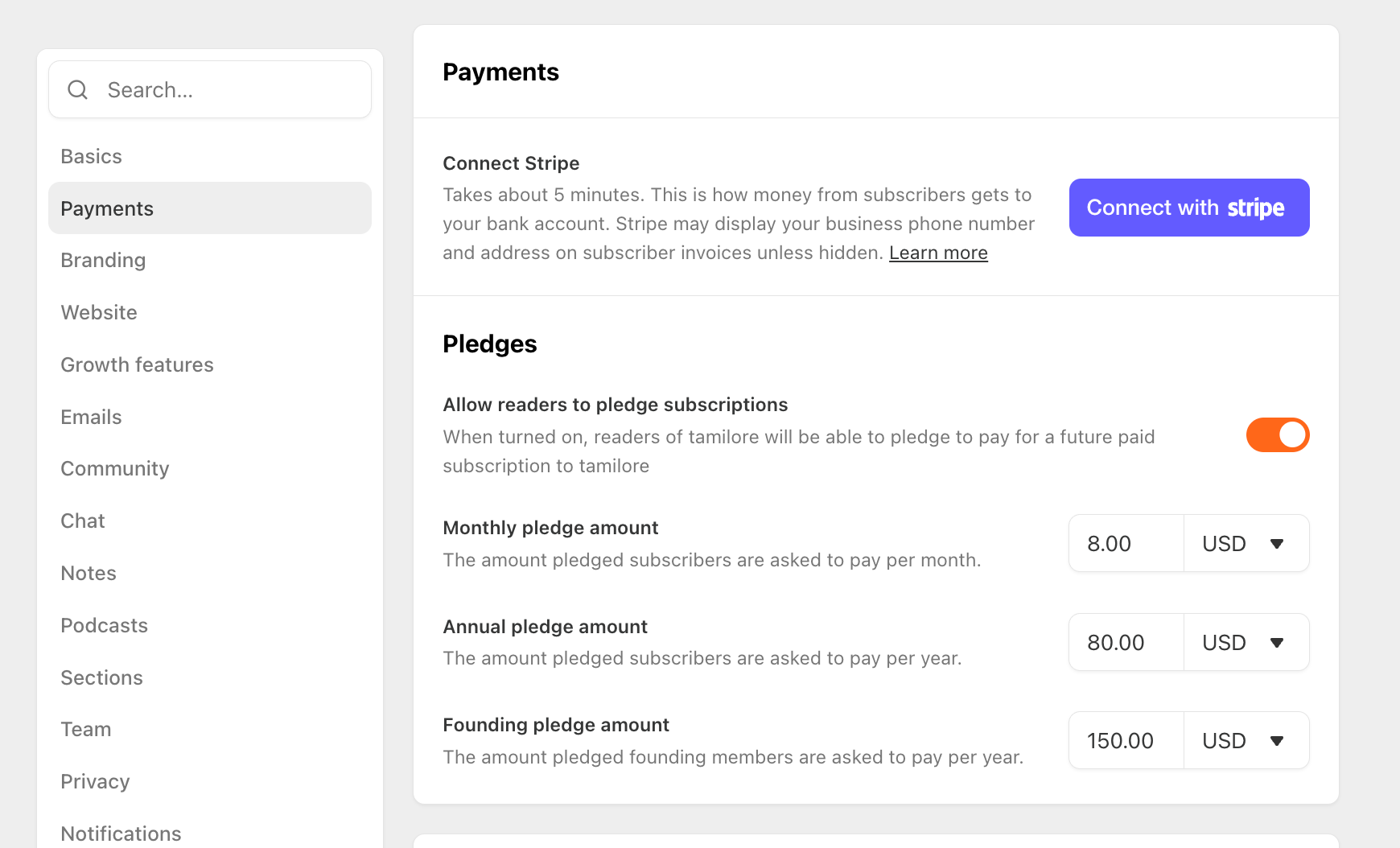
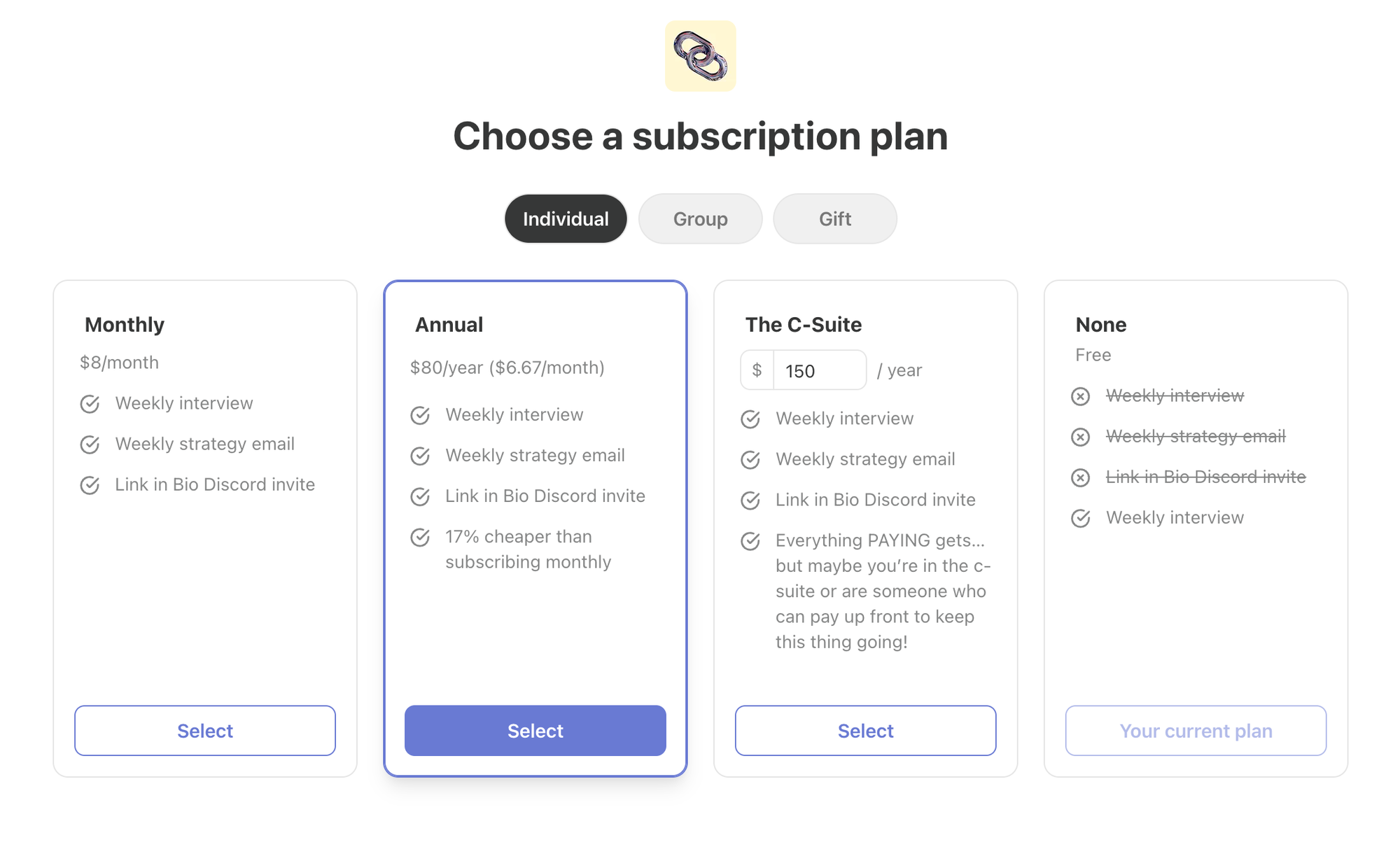
- What should you put behind a paywall? Not every post has to be paid—many successful Substack writers use a hybrid model, where some content remains free while premium content is for paid subscribers. "I publish four essays on Substack per month, and one of those is behind a paywall. This way, free readers get plenty of value while I still offer exclusivity to paid members,” says Anna Burgess Yang. The key is making your free content good enough that readers naturally want more. If your free content is valuable, people will be more inclined to support you financially.
- Explore other ways to make money on Substack: Paid subscriptions aren’t the only monetization option. Many Substack creators also earn through: sponsorships, affiliate marketing, one-time payments using platforms like Buy Me a Coffee for tips and consulting, courses, or products.
Getting people to subscribe for free is one thing. Getting them to pay is another.
Here are three ways to increase conversions:
- Be direct: Mention your paid tier in your emails (without being pushy). A simple line like "If you enjoy my writing, consider upgrading to a paid subscription" can make a difference.
- Offer a free trial: Substack lets you give potential subscribers a 7-day free trial to paid content. This lowers the barrier to entry.
- Highlight social proof: If others are paying, mention it! Readers are more likely to subscribe if they know they’re not alone.
Success Lawal shared one strategy she’s considering: "My plan is to have exclusives like video interviews and deep-dive research reports for paid subscribers. People will pay if they see a real difference in what they get."
Engage with your community to grow on SubstackIf you’ve made it this far, you have everything you need to start—and sustain—a successful Substack newsletter.
The most important element of growing on Substack is engaging with your audience.
Unlike social media, newsletters aren’t a one-way street. Your subscribers aren’t just followers—they’re people who care enough about your work to invite it into their inbox.
Encouraging replies, starting conversations, and making your readers feel valued can help create a loyal, engaged audience.
A prime example of this in action is Emily Sundberg, founder and author of Feed Me, a daily business newsletter on Substack. She has built more than just a newsletter—she’s created a media brand with a deeply engaged community, reaching ~50,000 subscribers and generating ~$400,000+ annually.
Melissa Blaser broke down what makes her so successful on LinkedIn, but what it boils down to is this: Her success isn’t just about writing great content—it’s about making Feed Me an interactive experience.
Readers don’t just want to consume content—they also want to participate. The more you engage with them, the more invested they become.
If you’ve been thinking about launching a Substack, consider this your sign to start. Your first post won’t be perfect. Your first 10 subscribers might just be friends and family. But every great newsletter started the same way — with one post and one reader.
So go ahead: sign up, write your first post, and hit publish.
- Home
- About Us
- Write For Us / Submit Content
- Advertising And Affiliates
- Feeds And Syndication
- Contact Us
- Login
- Privacy
All Rights Reserved. Copyright , Central Coast Communications, Inc.